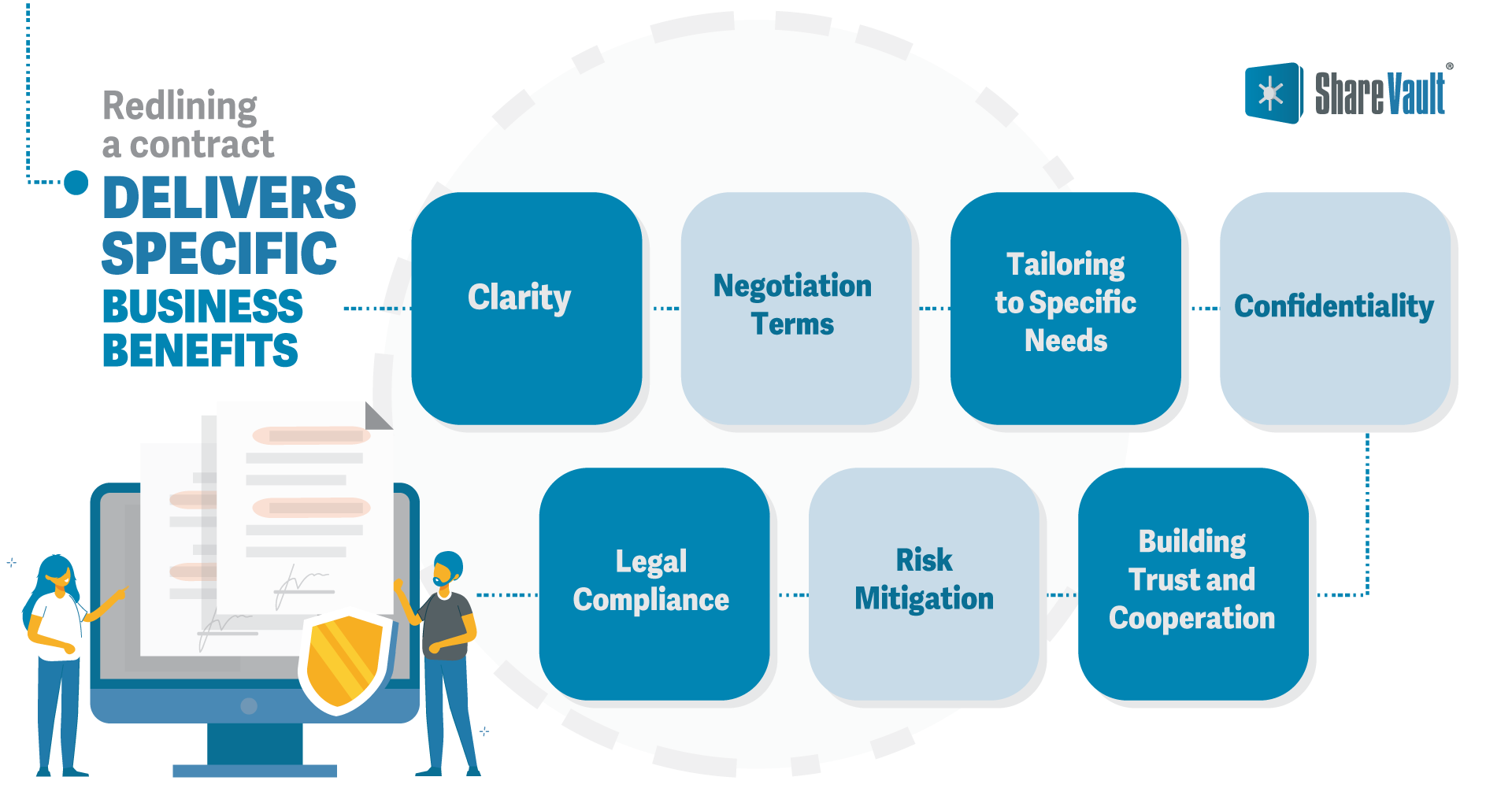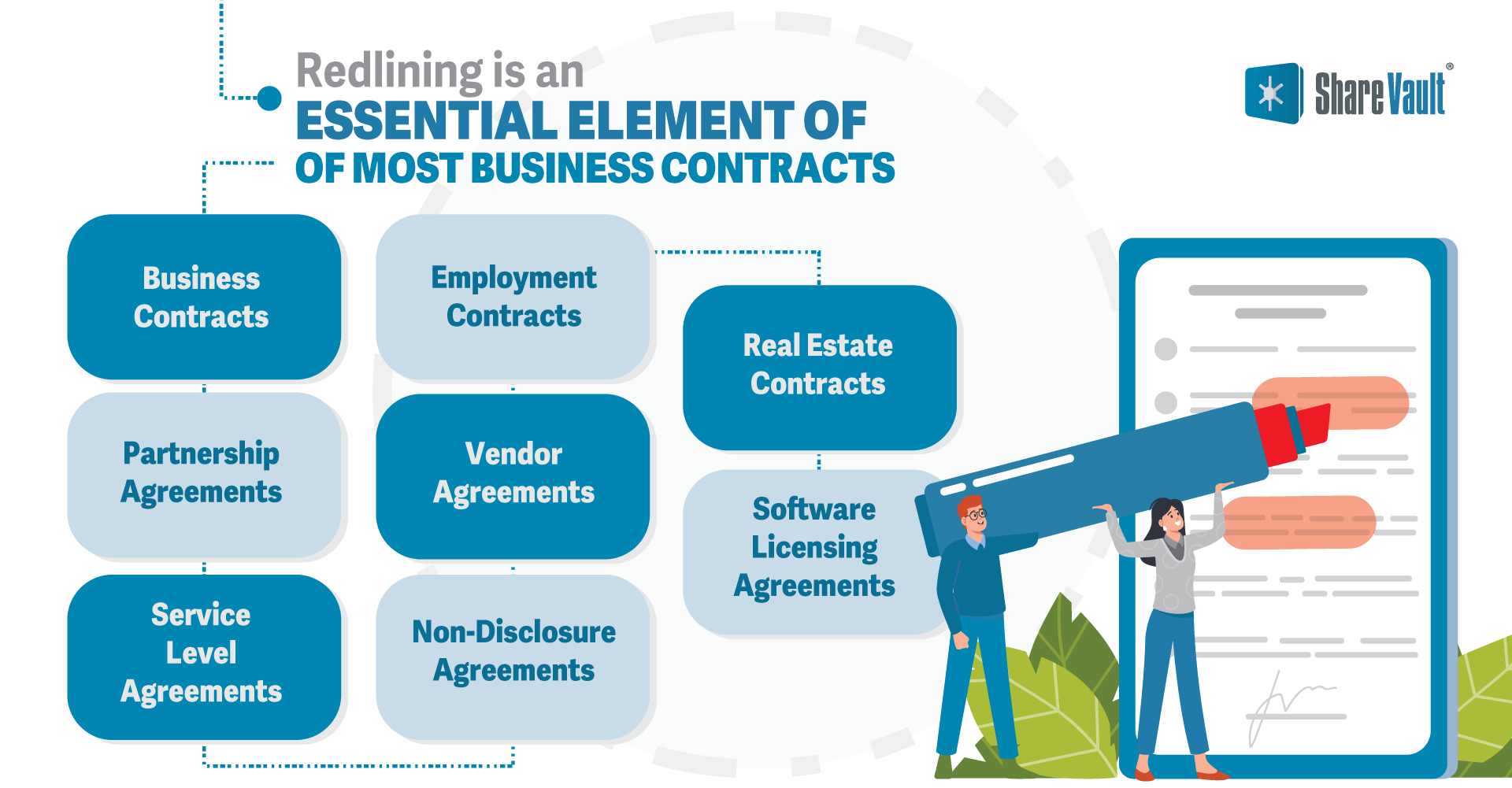In the context of business contracts, "redlining" refers to the process of marking up or editing a contract with changes, additions, or deletions. The term "redlining" originates from the pre-digital age, when an editor used a red pen to mark the suggested revisions on paper documents. Today, redlining is performed using digital tools to highlight areas under review and revision.
Benefits of Redlining a Contract
While each party may consult multiple documents in negotiating a contract, the redlining process focuses on an end goal of a single contract document. As such, every word or phrase takes on a larger significance.
Redlining a contract delivers specific business benefits

Clarity: As it is developed, a business contract may contain ambiguous or unclear language that could lead to disputes. The team originating the contract uses redlining to correct such ambiguities. When a contract is submitted to a customer, prospective partner, or other third party, the redlining process is repeated in a back-and-forth exchange until both parties agree on a document that clearly states their rights, obligations, and expectations.
Negotiation Terms: Redlining is often part of the negotiation process between parties. When one party receives a contract proposal, they will review it thoroughly and identify terms or clauses they disagree with or wish to modify. By redlining the contract and proposing specific changes, the other party can better understand their concerns and engage in a negotiation to reach mutually agreeable terms.
Tailoring to Specific Needs: Every business deal or agreement is unique, and a one-size-fits-all approach may not be suitable. Redlining enables each party to customize the contract to meet their specific requirements, ensuring that it reflects the nuances and particularities of their agreement.
Confidentiality: A company may use confidential documents and business information to generate a contract. During redlining, the contract development team deletes or redacts confidential information before it is submitted to the receiving party.
Legal Compliance: The legal compliance aspect of a redlining review ensures that the contract is legally valid and enforceable, which helps prevent legal challenges or disputes arising from non-compliance.
Risk Mitigation: Redlining can be used to address potential risks or liabilities that one party may find unacceptable. By modifying certain terms, conditions, or limitations, the finalized contract will reduce risk exposure.
Building Trust and Cooperation: When approached professionally and collaboratively, the redlining process illustrates that both parties are committed to reaching a fair and balanced agreement, which fosters trust between parties.
Redlining is an Essential Element of Most Business Contracts

Redlining is commonly required for a variety of contract types, including:
- Business Contracts: Businesses generate contracts for a wide range of agreements, for services, partnerships, joint ventures, or supply and distribution arrangements.
- Employment Contracts: Redlining may be used for employment agreements, especially when negotiating terms with senior executives or employees with specialized roles.
- Real Estate Contracts: Contracts related to buying, selling, or leasing property generally use templated contract forms, but often require redlining to clarify terms and protect the interests of both parties.
- Partnership Agreements: When forming a partnership, redlining is an essential process to clarify each partner's responsibilities, profit-sharing arrangements, and decision-making processes.
- Vendor Agreements: Contracts with suppliers and vendors may require redlining to establish pricing, terms of delivery, and other important aspects of the business relationship.
- Software Licensing Agreements: Software licensing contracts can vary as to the cost, duration, intellectual property rights and support. Redlining clarifies these terms.
- Service Level Agreements (SLAs): SLAs between service providers and customers often require redlining to specify performance standards and penalties for non-compliance.
- Non-Disclosure Agreements (NDAs): NDAs are used to protect confidential information. Redlining is the common practice to define the scope and limitations of the agreement.
Redlining Protects Confidential Information
In addition to its use in negotiating terms, redlining can be used to conceal or delete confidential and sensitive information in a document before sharing it with a third party, a redlining process called ‘redacting’. While the offering party retains the original version, the redacted version is what the third-party recipient sees.
This redlining redacting process is a common element for several business processes:
Mergers & acquisitions: M&A due diligence uses information from confidential internal documents to create an offer. Redaction allows the due diligence team to select how much information is to be shared with a potential bidder. For example, a seller might want to remove specific names or personal information associated with their company, or a buyer may want to remove any mention of a target company. M&A dealmakers know that a breach of information can delay or derail a deal or lead to litigation.
Investor briefs: As with M&A offers, redacting confidential information used to create an investor brief ensures confidentiality until the offer is accepted.
Litigation: Attorneys have an obligation to protect the privacy of parties involved in litigation or other legal proceedings. Legally redacted copy must be identical to the original paper copy, minus any redacted information. Failure to do so may result in court sanctions or fines.
How to Redline a Contract
Digital tools and software are commonly used for contract redlining. These tools provide collaborative editing features which make it easier for multiple parties to contribute, track changes, and comment on specific sections of the contract, all in real time.
During the redlining process, the original contract proposal document is examined to identify any provisions or sections that need changes, amendments, or further negotiation. To aid the process, each proposed change is identified and marked using specific formatting conventions, such as underlining a word or phrase or highlighting the copy in a different color.
Redlining Requires a Secure Environment

Both the team generating the contract and the team receiving it make extensive use of confidential documents to create and buttress claims and terms. Each side may also consult lawyers, accountants, and other subject matter experts in refining teams.
For both sides, security is critical. Archives of confidential company documents and collaborations within teams and with remote third parties are all perfect targets for hackers, not only the competition, but also professional cybercriminals.
The best solution to ensure a secure redlining process is a Virtual Deal Room (VDR), an online platform that protects documents. The VDR protects documents in multiple ways:
- With a quality provider like ShareVault, every document uploaded to the VDR is automatically encrypted
- Only authorized parties can enter the protected VDR online environment
- Additional security features, including permissioning protocols like two-factor passwords and device IP registration, ensure the contract and supporting documents are only accessible by the right people
A quality VDR provider like ShareVault also includes software to streamline the contract redlining process:
- The contract development teams can drag-and-drop upload a virtually unlimited number of reference documents
- ShareVault provides advanced document organization and sharing tools
- Authorized users can access the VDR from anywhere in the world, 24/7.
When the contract is ready for review, the initiating party can authorize password-protected access to the VDR for the receiving party, who can then review and redline their revisions in a secure and protected environment.
Collabloop is Secure Contract Redlining Software
In addition to providing a secure environment for storing reference documents, ShareVault has developed Collabloop, task management software specifically designed for redlining. Collabloop streamlines the redlining process and addresses security vulnerabilities in Word and Google Docs word processing apps:
- With Collabloop, both the contract development team and the customer team are always working on a single document
- When a party makes a comment or revision, their input is visible to everyone, much as it would in Word’s track changes annotations, but in real time, which improves the speed of collaboration. Collabloop can reduce the contract development project timeline by up to half
- Collabloop maintains a history of every version of a contract document with details of the date, time, and identity of the contributor, a useful tool for contract development teams and a necessary report for a regulatory audit
- Since Collabloop is housed in a ShareVault VDR, every version of the contract and all reference documents remain protected throughout the contract development process.
Collabloop integrates with DocuSign
Once the proposing and receiving parties have completed their redlining efforts and come to an agreement, Collabloop integrates with DocuSign and all its online features for the final signatures.
Collabloop 24-hour Support
ShareVault knows that with a contract on the line, time is everything. That’s why Collabloop users have round-the-clock support from the ShareVault IT team, who can answer questions and resolve issues quickly and efficiently.
ShareVault and Collabloop Save You Money
ShareVault’s secure virtual deal room and Collabloop’s redlining software provide maximum document security and speedy contract development. Since each company has unique document security needs, ShareVault feature sets and pricing are customizable. To receive a customized ShareVault proposal, contact us today!
